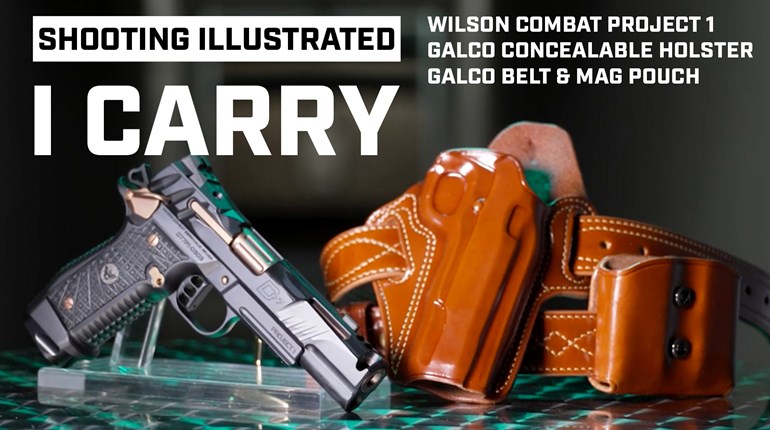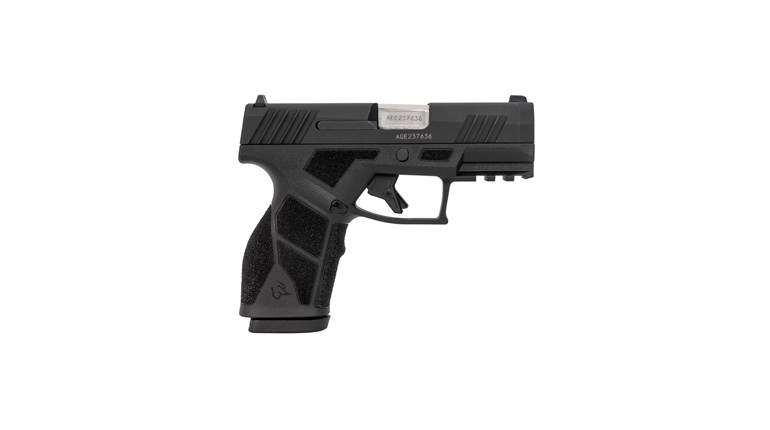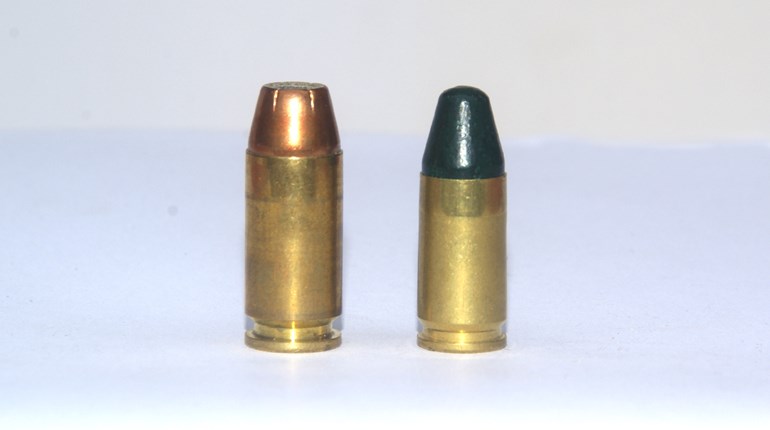
While I have come around regarding my initial reservations about polymer handguns, I still don't get emotional when first viewing a new model. Given my lifelong passion for handguns, that doesn't seem right—even though I fundamentally agree with a fellow gun writer who once said these handguns have no soul.
I respect the functionality of the polymer handgun as a defensive pistol and fully acknowledge the achievements this family of firearms has made in today's marketplace. I even admit the all-black semi-automatics have a businesslike look that is undeniably compelling if not emotionally inspiring. Yet, there is something so elegant about the functional simplicity I saw with my first glance at Smith & Wesson's SD, I had to acknowledge something was beginning to touch my emotions. Gnawing doubts began to assail me when I actually handled the company's new SD9 and SD40.
For detailed photos of the SD Series handguns, click here.
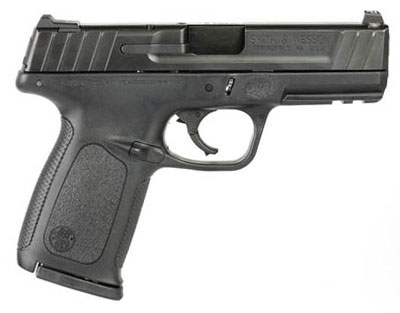
Typical of the breed, the SD handguns are striker-fired with polymer frames and steel components. The slide and barrel are made of steel. As with most standard-size, striker-fired handguns utilizing wide-body magazines, barrel length is 4 inches.
What started the change in my feelings for polymer guns was the fact both SDs looked extremely compact for what they offered in firepower. That impression was reinforced when I actually handled both the 9 mm and .40 S&W models. Given the 9 mm's 17-round capacity and the 15 rounds of .40 S&W (that's a full magazine plus one in the chamber), I was very impressed with the efficiency of the two guns.
Both grip circumference and length seemed unusually small and comfortable compared to similar guns I've worked with in the past. It struck me the pistol was designed as much for ergonomic satisfaction as maximum magazine capacity. The SDs weren't looking beautiful, but they were definitely acquiring a certain allure.
The SD is meant to fall between the company's Sigma and M&P lines, both in terms of features and price. As Smith & Wesson's Paul Pluff explained, beginning with the entry-level Sigma and proceeding up through the SD and M&P, "...it's a case of good, better and best." It's been a long time since I've handled a Sigma, but I've spent lots of time on the range with the M&Ps, and I must say the SD didn't give up much to its more expensive relative.
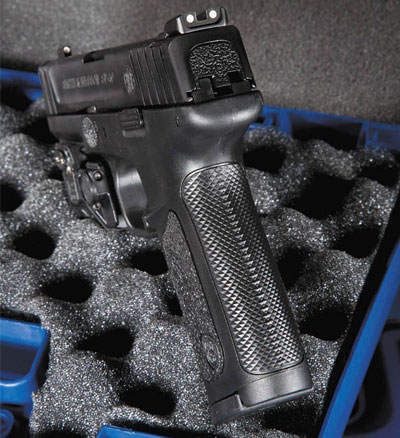
First, the SDs have rather small—but rock-solid—three-dot sights dovetailed into the slide, both front and rear. In addition, the front sight has a tritium insert in the dot. I still haven't cast my final vote regarding the necessity of white dots on a rear sight, but I do believe in a tritium insert up front for low-light encounters. The rear sight extends backward from the dovetail until it is flush with the rear of the slide. Not a big deal, but it does buy you an extra half-inch of sight radius, and for precision shooting, more sight radius is better than less. Its rear sight has a setscrew enabling adjustments for windage if necessary. The S-shaped silhouette of the rear sight provides a small, flat surface facing toward the muzzle that allows one-handed slide manipulation by pushing the flat portion against a hard surface, like the heel of your boot.
The slide has deeply defined serrations front and rear making chamber checks and other necessary manual manipulations (like clearance drills) quite easy. Manual chamber checks are particularly necessary because while there is a small hole in the slide above the chamber that—in good light—shows a glint of brass when a round is present; you won't see anything in low-light conditions. There is a long, external extractor that is 100-percent functional, but gives no indication whether or not a round is chambered.
There are a couple of interesting features molded into the polymer frame. First is a short, integral accessory rail onto which I slid a SureFire X300. It locks into place with an audible click. At present, SureFire doesn't make an X300 pressure-pad switch designated for the SD, but the unit from an older Springfield XD worked perfectly despite a gap in front of the trigger guard due to the different shapes of the two pistols. I've run through the fun house at Gunsite a couple of times, and it's easier to do with a weapon-mounted light instead of a handheld.
The sides of the SD frames are uncluttered, something I appreciate in a striker-fired gun without a manually operated safety. The slide-release latch extends no further from the frame than necessary and can be operated by the shooter's thumb with absolutely no shifting of your grip. Otherwise, the only other projections from the side of the frame are the two take-down levers. These protrude minimally past the frame's surface and rely on their tiny "teeth" to provide satisfactory purchase for operation.
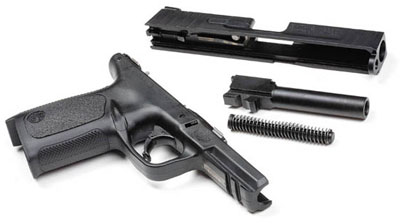
You may need to develop some additional dexterity to remove the slide like I did, but it's pretty easy after you've done it a few times. There are two football-shaped, dished-out recesses on the side of the frame in front of the take-down levers with textured surfaces. Part of my problem in disassembly of these guns was my assumption the indentations should be used in the process. A friend mentioned they are index marks for your trigger finger when sights are off target and for the support-hand thumb for those who shoot with their thumbs pointed forward. I tend to avoid contact between thumb and gun for fear of touching the slide and causing a malfunction. My trigger finger is much more comfortable when held lower on the slide. That said, I have no quarrel with index points that improve safety and enhance shooting skills. If it fits your shooting style, do it.
Molded into the grip, where the trigger guard joins the frame, are two little ridges or shelves that prevent the thumb from riding over the magazine-release button and inadvertently dropping the magazine. I had to shift my shooting grip slightly to release the magazine, but I do this on all semi-automatics. Besides, that slight shifting is easily learned and more preferable than the loss of your magazine.
The front and back of the grip frame have molded-in checkering, while the sides of the frame have cosmetic panels with minor, molded stippling. These surface alterations are understated, but more than adequate to control the gun during rapid-fire strings. Given the more noticeable recoil impulse of a .40 S&W compared to that of a 9 mm—particularly in a lightweight polymer handgun—you will have to determine if you're comfortable handling the larger caliber. I was pretty marginal on the .40, though if I concentrated on my grip I was OK. The slight flair of the molded magazine well, combined with the taper of the magazine's mouth, ensured reloads were very fast and smooth.
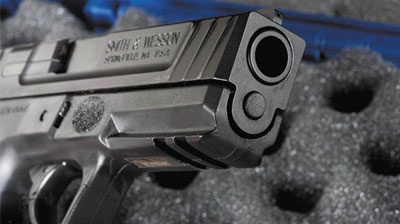
Shooting the SDs proved quite interesting. Frequently, when doing a chamber check, I grasp the slide near the muzzle and retract it just far enough to insert my trigger finger in the chamber and feel the presence of a round. With the 4-inch barreled SDs, the forward serrations are quite close to the muzzle and, if I wasn't concentrating on the front of the pistol, parts of my hand slipped in front of the muzzle. Besides being a violation of Rule 2, proper training dictates your attention/eyes are downrange looking for a threat, not on your gun. So for a variety of reasons, you might want to develop a slide-manipulation technique that involves grabbing the rear serrations. This is particularly true under stress, and what's a gunfight if not the ultimate moment of stress?
As previously stated, there is no external, manually operated safety on the SD models. Yes, there is the articulating trigger, but nothing that requires a separate and distinct manipulation to prepare the gun for firing. Many of us prefer that type of firearm, but this should serve to emphasize the importance of keeping your finger off the trigger until your sights are on target. In addition, if you carry the gun, you must use a holster that prevents anything from making contact with the trigger. Also, be aware the SD will fire a chambered round even if the magazine is removed. To me that's a good thing, because if there's some unexpected development during a tactical reload, you still have a live round ready for self-defense.
Trigger pull is not the SD's best feature, although the actual weight was lower than I expected. Trigger travel is about .5 inch, with the first 1⁄8 inch having very little resistance during the take-up-the-slack stage where the articulating trigger uses up all the space. The last 3⁄8 inch of travel reveals an increase in pull weight and a rather gritty feel throughout this portion of the pull. On the plus side, the average trigger pull on the .40 S&W was right at 8 pounds, while the 9 mm was 7.5 pounds. Oddly, although the .40 S&W was noticeably heavier, it felt crisper. The 9 mm was lighter, but it felt much more gritty. For close-range self-defense, I had no trouble working the triggers and staying in the vitals on both chest and head shots, though steel plates at 25 yards and beyond were considerably more difficult. At the NRA Annual Meeting and Exhibits I talked with a company looking at producing replacement drop-in triggers for the Smith & Wesson lineup of semi-automatics. I hope to try some of these in the future.
What I expected to be my biggest issue with the SD wasn't. At first glance the grip angles looked like a Glock, except with softer edges. That different grip angle has always forced me to retrain my hands and grip because my normal presentation results in the front sight sitting well above a long slide with no rear sight in the picture. When presenting the SDs, the front sight was slightly high, but much of the blade was located between the sides of the rear sight.
Quick shots at close range went perhaps an inch high, but still landed in the chest cavity. In fact, I may have gotten the front sight on target faster because I could see more of it. It seemed more prominently displayed, and there was no confusion about the location and orientation of the rear sight. I didn't bring out the timer, so this is just speculation. However, I was very comfortable handling and running the pistols.
At a suggested retail price of $459, Smith & Wesson's SD falls between the M&P and Sigma models. For that price you get the gun with two magazines, either standard capacity or limited to 10 rounds, depending on your state of residence. Whatever the capacity, either caliber represents a serious self-defense bargain.












